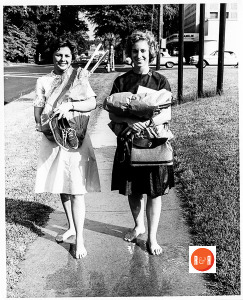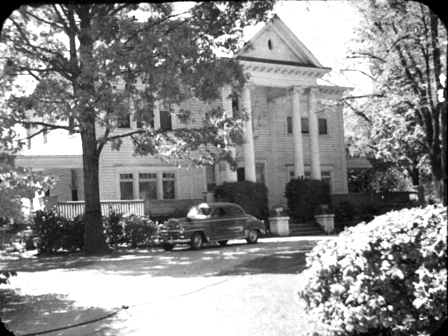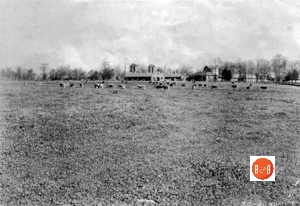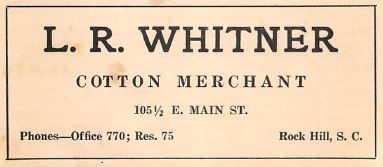“William Church Whitner was the engineer and designer of the power plant at India Hook.” – Louise Pettus, 2005
City Directories and History: 1908 – W.C. Whitner, (Listed as #205), 1917 – W.C. Whitner, 1925 Whitner Cotton Co., at 105 East Main St., 1936 – William C. Whitner, 1946 – Lyle R. Whitner, 1963 – Rock Hill National Bank
William C. Whitner, a native of Anderson, S.C. was a graduate in engineering from the University of South Carolina. His first work was in railroad engineering but a severe case of typhoid fever forced him into a long convalescence in his father’s home. While there the town of Anderson, S.C. asked him to build a water works systems and an electric plant. (Information via Louise Pettus – 2005)
The Herald via the Charlotte Observer reported on Sept. 16, 1899 – “Mr. C.W. Whitner of Rock Hill has employed architects Hook and Sawyer to prepare the plans for a handsome Colonial residence. Mr. Whitner’s residence will be the handsomest in Rock Hill and will be fitted with every modern convenience. Architect Sawyer spent yesterday in Rock Hill, viewing the site and making some minor changes in the plans.” On Sept. 20 the paper reported – ” Mr. W.C. Whitner has rented the dwelling in Oakland at present occupied by Mr. H.B. Buict.”
The Herald reported on Aug. 11, 1900 – “Capt. W.L. Roddey’s condition has improved and he was able to go to the summer home of W.C. Whitner and W.J. Roddey on the Catawba, where he will continue to improve. This is a delightful home with broad piazzas in the midst of a primeval forest and looking through an opening cut through the woods a beautiful view of the Catawba for perhaps a mile can be seen. It is a delightful spot…..”
The Herald reported on March 13, 1901 – “The plans for a dwelling to be erected on Oakland Ave., show that it will be a magnificent building, one of the best in the city.” On March 16th they reported – the new home of W.C. Whitner will be of Colonial design and will have ten rooms. It will be erected on the lot on Oakland Ave., opposite the home of J.M. Cherry.”
The Herald reported on Nov. 12, 1902 – “One of the finest farms we have seen is that of the Whitner’s located three miles north of the city. They grow oats and barley.”
William Church Whitner, born, Anderson, South Carolina, September 22, 1864, was graduated from the South Carolina College in Civil Engineering in 1885; he was chief engineer of the Anderson Light and Power Company, organized December 24, 1894, and began construction of the Portman Power Plant in 1896. The Portman power was turned on November 1, 1897. The cement used in the construction was imported from Belgium, and hauled by wagons to the site. Mr. Whitner determined to save costs by not having what is known as stepped-up transformers in order to obtain high voltage. Stanley Electric Company of Pitts-field, Massachusetts, (Subsequently purchased by the General Electric Company) was pioneering in this field and was the only company in America who would wind a generator for 10,000 volts. The Company offered to build these generators and Mr. Whitner was advised that these were the first 10-thread,
10,0 volt generators built anywhere in the world for commercial purposes to do the actual work.
The late James B. Duke, sent his engineers to Port-man to witness the experiment. The switchboard was built and equipped with single pole switches with long handles on them like a pitchfork; they were named “Ben Tillman Switches.” because of his fame and the nickname which was given him—“Pitchfork Ben.” The Stanley Electric Manufacturing Company, stationed a branch office in Anderson in 1896, for the supervision of the building and erecting the electrical plant at Portman. Material was shipped to Pendleton, and hauled over the old Portman Road to the construction site. (Other branches of Stanley were located at New York, Chicago, Boston, and San Francisco). Mr. William States Lee, began work at Portman in 1897, and got his first practical engineering experience under the direction of Mr. Whitner. Mr. Lee went on to become president of the P. & N. Electric Railway System and was Vice President of Duke Power Company until his death.
The plant at Portman was the first long-distance hydroelectric transmission plant built in the South. The importance of the Portman Plant as being a “first” in this category of electrical development must be regarded in the same relationship as the pioneer aviation at Kill Devil Hill, North Carolina, or the “first” Hamburg-Charleston Railway.
(Information from: Names in South Carolina by C.H. Neuffer, Published by the S.C. Dept. of English, USC)
The Herald reported on May 23, 1889 – “Mr. W.C. Whitner is engaged in surveying Main Street. The granite curbing from the Winnsboro quarry has been received and the work of grading the street will commence this week.”
The Herald contained an add on Dec. 18, 1890 – “Roddey & Whitner, Engineers and Contractors. Partners are J.T. Roddey and Wm. C. Whitner. The firm advertised surveys, plans and specification, building of railroad and bridges, and draining land.”
The Charleston News and Courier of June 7, 1890 stated – “One of the most important firms in Rock Hill is the firm of Roddey and Whitner, civil engineers and contractors. They make surveys of all kinds. Construct water works, build railroad, and construct canals. At present this firm is engaged in erecting the waterworks at Anderson and have numerous other contracts. Both are young men of rare ability and well known. They built a large portion of the 3 C’s Railroad, and Mr. Whitner built the bridge over the Catawba River where the road crosses it. “

Construction of the Catawba Hydro Electric plant on the Catawba River.

Stock certificate in the Whitner Cotton Company.
The S.C. Architects: 1885 – 1935, Wells and Dalton, 1992 – Reported “that the W.C. Whitner home was designed by Charles C. Hook in 1899.” The Whitner family had acquired the property the year before construction began.
The Herald reported on June 12, 1901 – “that Mr. Whitner has a contract with the city to make a diagram of every tract and lot in the city with a description of the buildings and property. He will be assisted by W.G. Adams of Darlington, S.C.”
The Herald reported on Aug 10, 1901 – “That W.C. Whitner has completed a survey of the lower road, from the state farm, to the county bridge over the Catawba River. The distance in 4.5 miles and the road is perfectly straight.” (The map shown in the More Information link is believed to be the result of this survey.)
The Rock Hill Record reported on April 4, 1907 – “Major B. F. Whitner, formerly of Anderson, is now living in Rock Hill with his son William and has sold his handsome home in Anderson. It was located in the western part of the city known as Rose Hill and included eight acres. The property has frontage on Whitner and Webb Streets. It was bought by J. M. and G. W. Evans.”
Mr. Whitner had come to Rock Hill to work with investors across the region and ultimately designed a successful hydroelectric plant in Anderson County, S.C., becoming known as the “Electric City” due to Mr. Whitner’s engineering success. He later working with his father-in-law and family member Dr. Gill Wylie in successfully creating the Lake Wylie hydroelectric power plant – dam. His engineering talents enabled and were instrumental in bringing electric power to Rock Hill’s cotton mills and later homes. He continued working with Wm. “Joe” Roddey and Dr. W. Gill Wylie of Chester and New York, to improve the original power source. The project was eventually sold to Mr. Duke of N.C., becoming part of the Duke Power empire.

Ad for the Riverview Dairy in 1925.
The Herald reported on May 21, 1902 – “A visit to the works of the power company shows wonderful advancement under the management of W.H. Wylie and Supt. Mr. Briggs. About half the stone work of the dam and two thirds of the power plant are completed. About 300 workers are employed. Some of the huge machinery is being placed. Many of the heaviest pieces have yet to be hauled to the site from Old Point. Six pieces weight 18,000 lbs each and four pieces way 25,000 lb. each. Trucks will be made especially for this purpose and the bridges must be strengthened and widened. The power plant will be 40 – 180 ft., and will have ten mammoth turbine wheels. The engineer in charge is Mr. W.C. Whitner, who drew the plans. He is assisted by Mr. C.K. Chrietzberg. Mr. Sims Wylie of New York is in charge of the books and Mr. Will McFadden is in charge of the commissary.”
Article on Mr. Whitner by Paul M. Gettys – 2016
The following sketch is based on an article in the Rock Hill Herald printed on May 13, 1940 following the death of Mr. Whitner.
William Church Whitner died at his home at 206 Oakland Avenue in Rock Hill recently at the age of 75. A pioneer in the development of electrical energy in the southeast, he will probably be best remembered as the first man to perfect a practical method of transmitting high voltage current from hydro-generators over long distances to consumers.
Mr. Whitner was born in 1864 in Anderson, South Carolina. His parents were Major Benjamin Franklin Whitner, a Civil War veteran, and Anna P. Church Whitner, whose father was President of the University of Georgia. Whitner graduated from the University of South Carolina with degrees in science and civil engineering. He was an assistant professor of math and engineering for a time. Late in his life, he was presented an honorary degree from the University in 1937.
His first work was with railroads. He became an assistant engineer surveying a rail line from Newberry to Augusta and later a division engineer on the rail line from Camden to Johnson City, Tennessee. He developed a partnership with John T. Roddey of Rock Hill to provide engineering services for railroad companies.
In the 1890s, he was hired by the City of Anderson to develop a system of waterworks and a steam electric light plant, which was completed in 1900. While in Anderson, Whitner became convinced that the use of water power to generate electricity would be a more efficient system than steam power. This would entail a large hydroelectric facility on a river, which would require the transportation of the generated electricity over distances to reach the cities which needed the power. The idea of transporting electricity over distances was not considered practical at the time. Whitner had difficulty raising capital for his plan for a large-scale plant at Portman Shoals on the Savannah River. Instead, to prove his theories, he decided to build a smaller plant at High Shoals near Anderson. He developed a dam and purchased generators. This facility proved his system of transporting electricity would work, and the owners of the Anderson Cotton Mills soon placed a thirty-year contract for the supply of electricity.

James Beaty of Winnsboro and Rock Hill driving his buggy down Oakland Ave. In the rear is the Whitner house. Courtesy of the Baily Collection
In 1899, Whitner sold his Anderson interests and moved to Rock Hill. He married Katherine Roddey, the daughter of Capt. William Lyle Roddey, a leading figure in the Rock Hill business community. Within a few years, he had designed and built three hydroelectric facilities in Georgia, and he began planning for a major plant on the Catawba River near Rock Hill. He selected the India Hook area of the river as the best option for providing power to the rapidly growing Rock Hill and Charlotte areas. He associated with Dr. W. Gill Wylie and Dr. Robert H. Wylie of New York City. These men, natives of Chester County, saw the great potential in hydropower, and were leading investors in the field. The Catawba Power Company was formed, and construction continued at the India Hook site between 1901 and 1903. The first contract for sale of power from the facility was with the Globe Cotton Mill in Rock Hill, later known as a Victoria Mill. William Lyle Roddey, Whitner’s father-n-law, was a major investor in this factory. The dam at India Hook, later greatly enlarged, has had a major impact on the landscape and economy of the Rock Hill-Charlotte area. The impoundment became known as Lake Wylie, and the hydro facility became one of the first elements of the Duke Power Company system.
While the India Hook plant was nearing completion, Whitner moved to Richmond, Virginia and built three plants for the Virginia Railway and Power Company in Richmond and Petersburg. He remained a consulting engineer for this company for twenty years.
He later returned to Rock Hill and in 1910 was elected to the first Public Service Commission for the City of Rock Hill. His fellow commissioners were F. J. Keller and Dr. J. B. Johnson, the President of Winthrop College. In 1915, he organized William C. Whitner & Company as a consulting engineering firm. His partners were Cecil L. Reid, Sr. and Jr. This company organized and built a number of power plants across the south. Whitner became interested in farming and organized the Riverview Dairy in 1924. In his later years, he was best known in Rock Hill for the operation of this 1,000-acre farm.
The article lists five children who survived him: Mrs. Hamilton McKay, Harry Whitner, Mrs. Tom Henderson, Lyle R. Whitner, and W. C. Whitner, Jr. His funeral service was held at Oakland Avenue Presbyterian Church, and he was buried at Laurelwood Cemetery in Rock Hill. Pallbearers at the funeral were W. J. Roddey, Jr., John T. Roddey, Oran Poe, Frank Law, Roddey Reid, R. B. Walker, Dr. Frank Strait, Jr., and Dr. E. J. Wannamaker.

Winthrop students returning from downtown Rock Hill pictured in front of the Willis Home. Note the Pix Theatre is in the rear. Courtesy of the Pettus Archives (Azer Collection), at Winthrop Archives.
Click on the More Information > link found below the picture column for additional data or pictures. Or click HOME to be returned to the Oakland Tour.
Stay Connected
Explore history, houses, and stories across S.C. Your membership provides you with updates on regional topics, information on historic research, preservation, and monthly feature articles. But remember R&R wants to hear from you and assist in preserving your own family genealogy and memorabilia.
Visit the Southern Queries – Forum to receive assistance in answering questions, discuss genealogy, and enjoy exploring preservation topics with other members. Also listed are several history and genealogical researchers for hire.
User comments welcome — post at the bottom of this page.
Please enjoy this structure and all those listed in Roots and Recall. But remember each is private property. So view them from a distance or from a public area such as the sidewalk or public road.
Do you have information to share and preserve? Family, school, church, or other older photos and stories are welcome. Send them digitally through the “Share Your Story” link, so they too might be posted on Roots and Recall.
User comments always welcome - please post at the bottom of this page.


 The old Whitner Home once stood on the corner of Wilson Street and Oakland Avenue.
The old Whitner Home once stood on the corner of Wilson Street and Oakland Avenue.























Share Your Comments & Feedback: